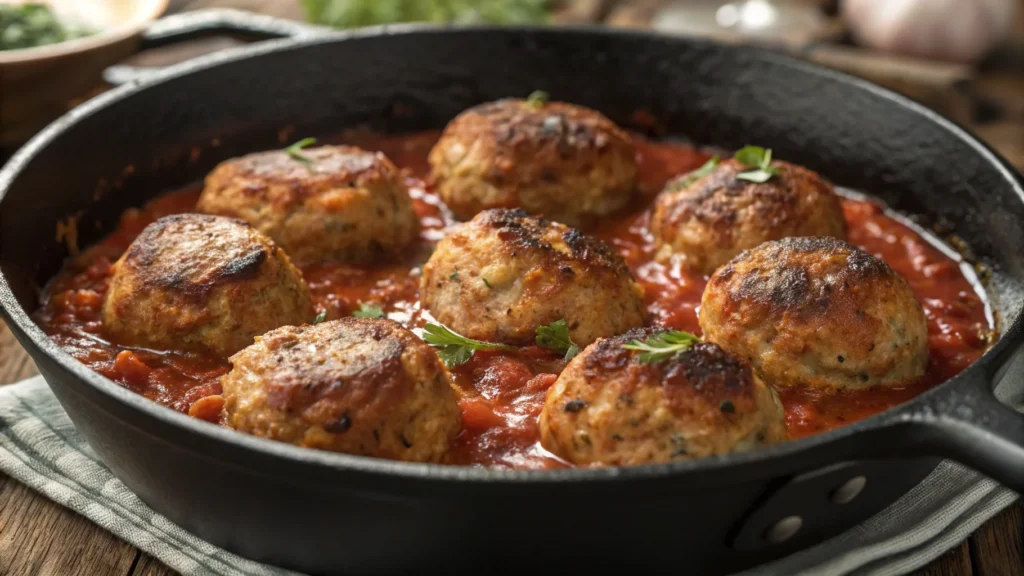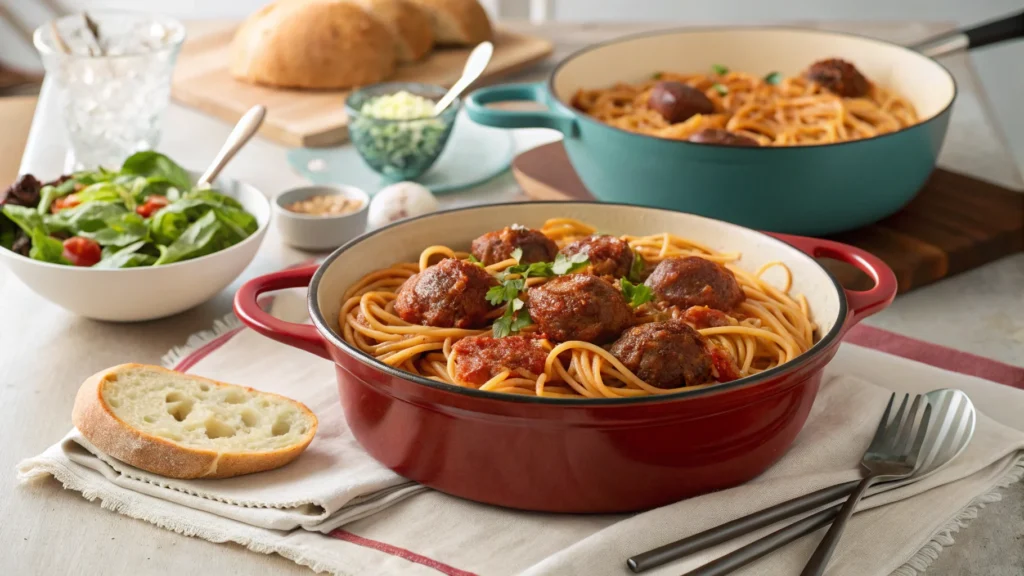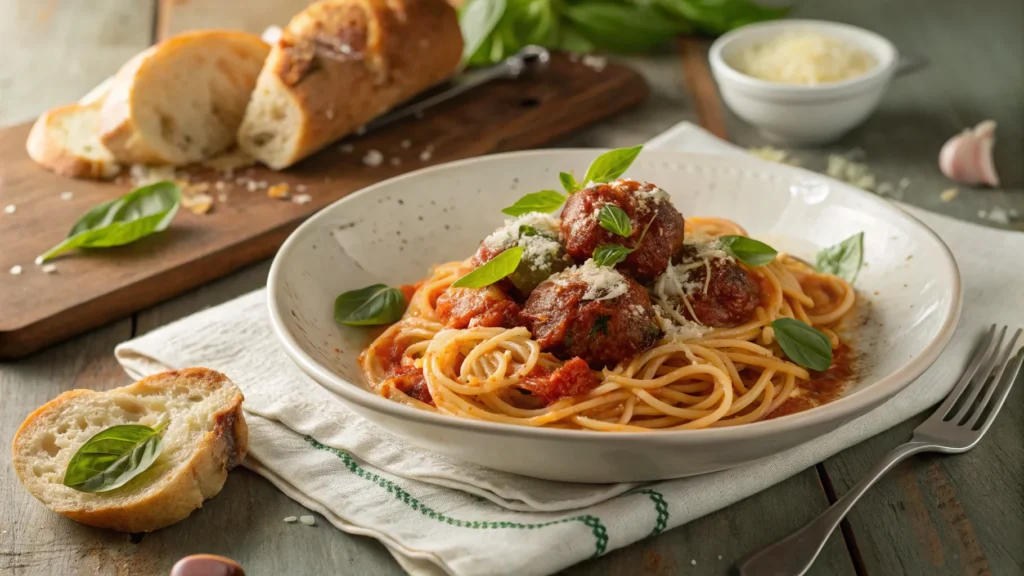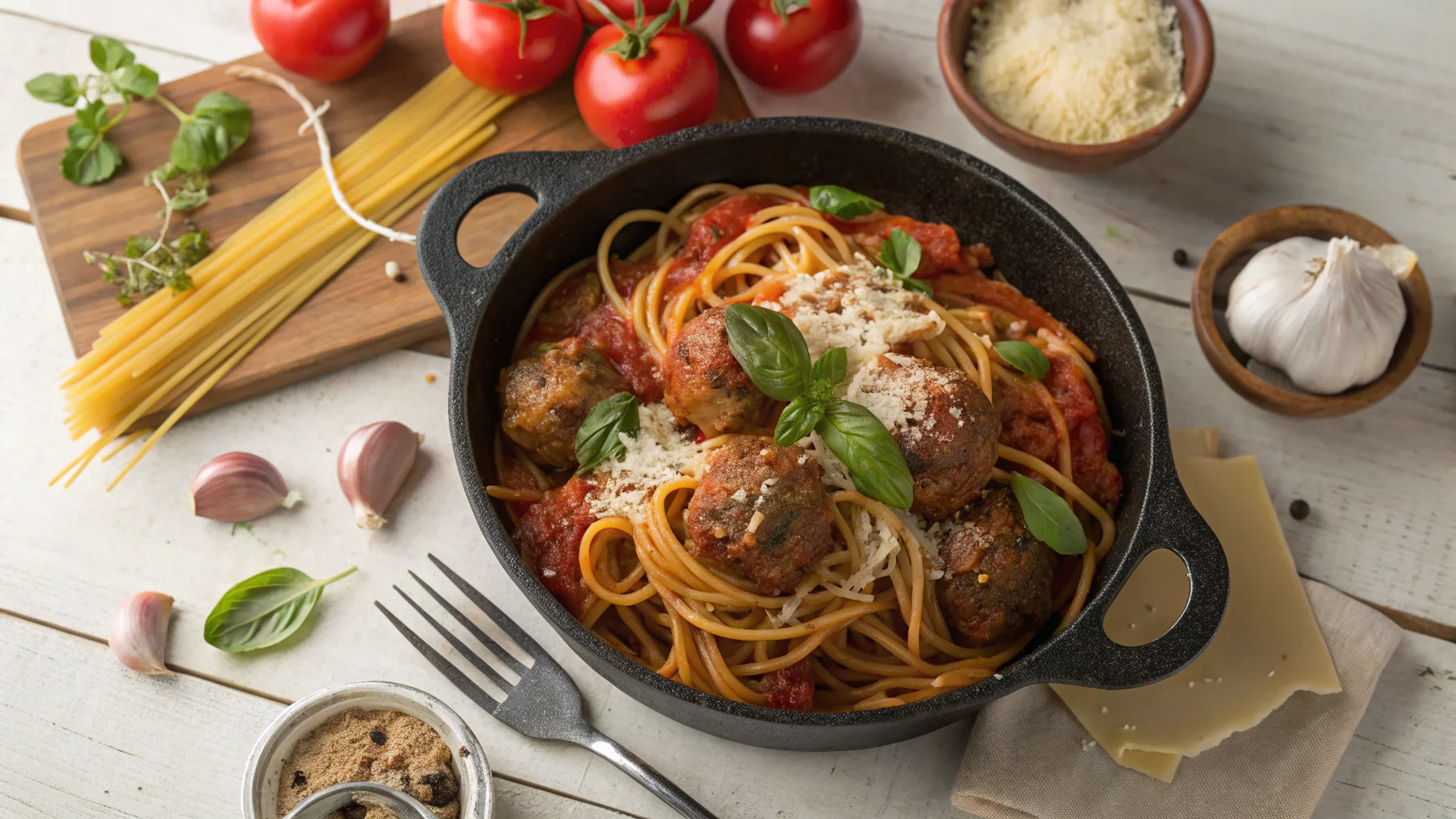Cooking spaghetti and meatballs in a Dutch oven brings a blend of tradition and convenience to your kitchen. This one-pot wonder combines tender meatballs, rich marinara sauce, and perfectly cooked spaghetti, all infused with the flavors of slow, even cooking. In this article, we’ll explore everything from selecting the right ingredients to mastering the cooking process. Along the way, you’ll discover tips, tricks, and serving suggestions to make this classic Italian dish unforgettable.
Let’s dive in with an introduction to Dutch oven cooking and why it’s the ultimate tool for creating restaurant-quality meals at home.
Table of contents
- Introduction to Dutch Oven Cooking
- Ingredients for Spaghetti and Meatballs
- Preparing the Meatballs
- Cooking Meatballs in the Dutch Oven
- Simmering the Marinara Sauce
- Cooking the Spaghetti in the Dutch Oven
- Serving and Presentation Ideas
- Troubleshooting and Expert Tips
- FAQs
- Wrapping It Up: Why This Recipe is a Winner
Introduction to Dutch Oven Cooking
What is a Dutch Oven and Why is it Perfect for This Dish?
A Dutch oven is a heavy-duty cooking pot made from cast iron, often coated with enamel. Its ability to retain and distribute heat evenly makes it perfect for spaghetti and meatballs. Unlike other pots, the Dutch oven’s thick walls maintain a consistent temperature, allowing the meatballs to cook thoroughly and the marinara sauce to simmer without scorching.
Advantages of One-Pot Cooking for Spaghetti and Meatballs
One-pot cooking is a lifesaver for busy cooks. By preparing spaghetti and meatballs in a Dutch oven, you save time on cleanup and enhance the dish’s flavor. As the meatballs simmer in the sauce, they release juices that blend with the marinara, creating a depth of taste that’s hard to replicate in separate pans.
The Role of Even Heating in Enhancing Flavors
A hallmark of Dutch oven cooking is its ability to trap moisture and distribute heat evenly. This method ensures tender, juicy meatballs and pasta cooked to perfection. Whether you’re browning meatballs or simmering sauce, the Dutch oven delivers consistent results every time.
Now that you understand why the Dutch oven is the star of this dish, let’s explore the key ingredients you’ll need to craft the perfect spaghetti and meatballs.

Ingredients for Spaghetti and Meatballs
Choosing the Best Meat for Meatballs
The heart of spaghetti and meatballs in a Dutch oven is the meatballs themselves. To achieve juicy, flavorful results, opt for ground beef as your primary choice. For a leaner option, you can substitute ground turkey or chicken. Just remember to add extra breadcrumbs or an egg to ensure the meatballs remain moist and tender.
When it comes to seasoning, don’t hold back! Garlic, onions, parsley, and Italian herbs like basil and oregano bring the meat to life. A pinch of red pepper flakes adds a subtle kick, while Parmesan cheese enriches the flavor.
The Secret to a Flavorful Marinara Sauce
A good marinara sauce can make or break your spaghetti and meatballs. If time allows, create your sauce from scratch. Use high-quality canned tomatoes, such as San Marzano, for a rich, authentic taste. Simmer the tomatoes with garlic, onions, olive oil, and fresh or dried herbs.
Pressed for time? Store-bought marinara works too, but consider enhancing it with fresh basil, a dash of sugar to balance acidity, or a sprinkle of Italian seasoning for extra flavor.
Additional Ingredients to Elevate the Dish
It’s the small touches that take your spaghetti and meatballs in a Dutch oven to the next level. Adding a bay leaf during simmering infuses the sauce with a subtle earthiness. For extra depth, try stirring in a tablespoon of tomato paste or a splash of balsamic vinegar. Don’t forget the pasta—choose high-quality spaghetti that holds its texture during cooking.
Preparing the Meatballs
Mixing the Ingredients: The Perfect Meatball Blend
To create tender, flavorful meatballs, start by mixing your ground meats with breadcrumbs, milk, and an egg. This combination acts as a binder, keeping the meatballs moist and tender. Add garlic, Parmesan, parsley, and Italian seasoning to the mixture for a burst of flavor.
Be careful not to overmix; doing so can lead to dense, tough meatballs. Gently fold the ingredients until just combined, ensuring every bite is packed with flavor.
Shaping and Seasoning Tips for Consistency
When forming meatballs, consistency is key. Aim for uniform sizes, about one to two inches in diameter, to ensure even cooking. Use a cookie scoop or lightly oiled hands to roll them into perfect spheres. A light dusting of flour before cooking helps the meatballs retain their shape.
Common Pitfalls: How to Prevent Meatballs from Falling Apart
Ever had a meatball crumble in the pot? To avoid this, ensure your mixture isn’t too wet—adjust with breadcrumbs if needed. Searing the meatballs in your Dutch oven before adding sauce creates a flavorful crust and locks in juices. This extra step ensures your spaghetti and meatballs in a Dutch oven come out perfect every time.
With your ingredients prepped and meatballs ready, it’s time to fire up your Dutch oven and start cooking!

Cooking Meatballs in the Dutch Oven
Searing vs. Poaching: Which Method Works Best?
When making spaghetti and meatballs in a Dutch oven, the cooking method you choose for the meatballs can greatly impact the dish’s flavor and texture. Searing the meatballs first creates a caramelized crust that locks in juices and adds a smoky depth to the overall flavor. To sear, heat a small amount of olive oil in your Dutch oven and cook the meatballs in batches until they’re golden brown.
Alternatively, poaching meatballs directly in the marinara sauce yields incredibly tender results. This method allows the meatballs to absorb the rich flavors of the sauce as they cook. If you’re short on time or prefer softer meatballs, poaching is the way to go.
Achieving a Perfect Brown Crust for Flavor
Searing meatballs requires careful attention to prevent sticking. Ensure your Dutch oven is preheated and the oil is shimmering before adding the meatballs. Avoid overcrowding the pot—this ensures even browning and prevents steaming. Flip them gently to maintain their shape and achieve a golden crust on all sides.
Retaining Juiciness in the Meatballs
To keep your meatballs moist during cooking, avoid overcooking them. Whether searing or poaching, they only need 10–12 minutes to cook through. Test one by cutting it in half; if the center is no longer pink, they’re ready. This balance of flavor and texture makes your spaghetti and meatballs in a Dutch oven a crowd-pleaser every time
Simmering the Marinara Sauce
Step-by-Step Guide to Creating a Rich Sauce
A great marinara sauce is the backbone of any spaghetti and meatballs in a Dutch oven recipe. Start by sautéing finely chopped onions and garlic in olive oil until fragrant. Add canned San Marzano tomatoes, breaking them up with a wooden spoon. Stir in tomato paste for added depth and richness.
Next, season the sauce with salt, pepper, dried oregano, and a pinch of red pepper flakes. Let it simmer for 15–20 minutes, stirring occasionally to prevent burning. For a smoother sauce, use an immersion blender before adding the meatballs.
Balancing Acidity and Sweetness in Marinara
Tomatoes can be naturally acidic, so balancing the flavors is crucial. Add a teaspoon of sugar to counteract the acidity or a splash of balsamic vinegar for a more complex sweetness. Fresh basil leaves, stirred in during the final minutes of cooking, bring a bright, herbal note to the dish.
Infusing Flavors with Herbs and Garlic
The Dutch oven’s even heating allows the sauce to simmer gently, giving the herbs and garlic time to meld into the tomatoes. Don’t rush this step—slow cooking enhances the flavor, making every bite of your spaghetti and meatballs in a Dutch oven unforgettable.
Next, we’ll dive into cooking the spaghetti and assembling the final dish.
Cooking the Spaghetti in the Dutch Oven
How to Cook Pasta Directly in the Sauce
Cooking spaghetti directly in the sauce is a game-changer for both flavor and convenience. Once your meatballs and marinara are simmering, remove the meatballs temporarily to make room. Add uncooked spaghetti to the Dutch oven, breaking it in half if necessary to fit. Stir it gently to ensure the strands don’t stick together.
Pour in just enough water or broth to cover the pasta, usually about two cups, and bring the mixture to a gentle boil. Stir occasionally as the pasta cooks, allowing it to absorb the rich flavors of the sauce. This method eliminates the need for a separate pot and intensifies the dish’s savory taste.
Tips for Avoiding Overcooked or Sticky Spaghetti
To avoid mushy pasta, keep an eye on the cooking time. Check the spaghetti for doneness a minute or two before the package instructions suggest. If it’s still a bit firm, let it simmer a little longer, but be careful not to overdo it. Adding the meatballs back into the sauce during the final minutes of cooking lets all the flavors meld together beautifully.
Using Pasta Water to Enhance Sauce Consistency
Don’t pour out all the pasta water! The starches released during cooking help thicken the sauce and give it a silky texture. If the sauce looks too thick after the spaghetti cooks, stir in a splash of reserved pasta water until it reaches the desired consistency. This step ensures your spaghetti and meatballs in a Dutch oven turn out perfectly balanced every time.
Serving and Presentation Ideas
Garnishes and Final Touches for Visual Appeal
When it’s time to serve your spaghetti and meatballs in a Dutch oven, presentation matters just as much as taste. Sprinkle freshly grated Parmesan cheese over the top for a creamy finish. A handful of chopped parsley or fresh basil adds a pop of color and a burst of freshness.
For extra flair, drizzle a bit of high-quality olive oil or add a pinch of crushed red pepper for a hint of heat. Serve directly from the Dutch oven for a rustic, family-style feel that keeps the food warm and inviting. Pairing Suggestions: Freshly baked bread, garlic knots, or a crisp green salad make excellent accompaniments to complete the meal.
How to Serve for Family-Style Dinners
Serving spaghetti and meatballs in a Dutch oven makes hosting a breeze. Set the Dutch oven in the center of the table with a ladle and let everyone help themselves. Not only does this style feel warm and welcoming, but it also keeps cleanup to a minimum.
With your dish ready to impress, the next steps will explore common cooking tips and answer frequently asked questions to ensure your recipe is flawless.

Troubleshooting and Expert Tips
Fixing Common Issues (Undercooked Pasta, Watery Sauce)
Even the best recipes for spaghetti and meatballs in a Dutch oven can hit a snag. If your spaghetti turns out undercooked, don’t worry—just add a bit more liquid to the pot (broth or water works) and let it simmer for another couple of minutes. Stir frequently to prevent sticking.
On the other hand, if your sauce ends up watery, don’t panic. Simmer the pot uncovered to let some of the excess liquid evaporate. Alternatively, stir in a spoonful of tomato paste to thicken it quickly without compromising flavor.
Maintaining the Dutch Oven for Longevity
A well-maintained Dutch oven is essential for consistently great results. To protect the enamel coating, avoid using metal utensils that might scratch the surface. After cooking, let the pot cool before washing it to prevent cracks from temperature shock. Regularly seasoning a cast-iron Dutch oven ensures it stays non-stick and rust-free.
Suggestions for Making the Recipe Gluten-Free or Dairy-Free
For gluten-free spaghetti and meatballs in a Dutch oven, substitute traditional spaghetti with gluten-free pasta. Ensure your breadcrumbs are also gluten-free, or swap them for almond flour. For a dairy-free version, skip the Parmesan and use a plant-based cheese or nutritional yeast for a cheesy flavor.
FAQs
Can I Make This Recipe Ahead of Time?
Absolutely! Preparing spaghetti and meatballs in a Dutch oven ahead of time can enhance the flavors. Cook the meatballs and sauce a day in advance, then store them in the fridge. When ready to serve, reheat on the stovetop and cook the spaghetti fresh to avoid sogginess.
What’s the Best Way to Reheat Leftovers?
Reheating is simple! Place your leftovers in the Dutch oven and warm them over medium heat, stirring occasionally. Add a splash of water or broth to loosen the sauce if it has thickened.
Are There Vegetarian Alternatives for the Meatballs?
Yes, vegetarian meatballs are an excellent option. Use plant-based ground meat or make your own with lentils, chickpeas, or mushrooms. These alternatives cook similarly in the sauce, making them a seamless substitute.
Can I Use Store-Bought Marinara Sauce?
Of course! Store-bought marinara sauce saves time and works perfectly in this recipe. To enhance the flavor, add fresh herbs, garlic, or a pinch of Italian seasoning while it simmers in your Dutch oven.
With these tips and answers, you’re ready to create an unforgettable meal. Cooking spaghetti and meatballs in a Dutch oven is not only easy but also a guaranteed crowd-pleaser!
Wrapping It Up: Why This Recipe is a Winner
Cooking spaghetti and meatballs in a Dutch oven is an excellent way to enjoy hearty, family-friendly meals. If you’re a fan of versatile recipes that bring rich flavors to your table, why not explore other comforting classics? For example, you can try making homemade cucumber salad with smoked salmon as a refreshing appetizer or pair this dish with warm Irish breakfast tea for a cozy dining experience.
Looking for dessert ideas to complete your meal? Check out this decadent heavenly hash brownies recipe for a sweet finish. These simple, indulgent treats are perfect for serving alongside Italian-inspired dinners.
For more cooking tips and inspiration, explore the recipe collection on Recipes Olly. You’re sure to find something new to try!

